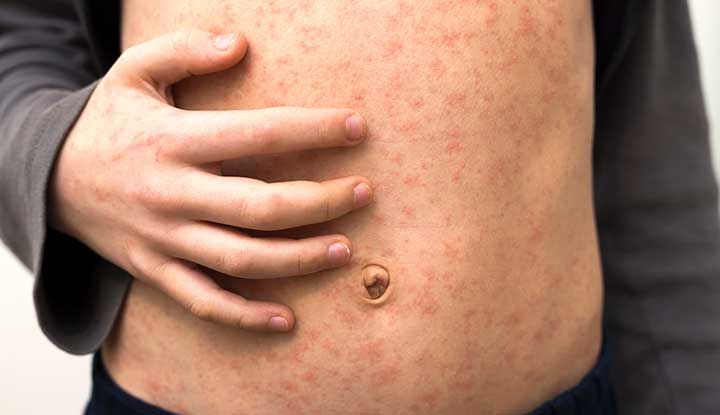

Measles in infants can be life-threatening.
Photo/Centers for Disease Control and Prevention (DCD)
‘Our population is at risk’: Pacific communities urged to get measles vaccine
Pacific communities are being encouraged to get the MMR vaccine to prevent a repeat of 2019’s deadly measles outbreak in Samoa.


Float First: A message for Pacific families during the holidays



Father of 12 killed in US church shooting as police hunt for gunmen

Float First: A message for Pacific families during the holidays


Health professionals are racing to administer measles vaccines in Pacific communities, and warn the outcomes could be severe if vaccination rates don’t improve.
Southpoint Family Doctors Dr Fiona Mariner-Shepherd said it’s not a matter of if, but when a measles outbreak will happen.
“When it comes, it will spread and find individuals and families who are not vaccinated, that will allow the virus to grow and to spread.
“But if most of our people are vaccinated, it is very limited in its ability to spread, and so it dies out.”
Complications from measles can include ear infections, diarrhoea and swelling of the brain in rare cases, and cause pregnancy complications.
“Measles is highly contagious, meaning it spreads very easily, and it spreads through the air simply through a cough or sneeze, so most unvaccinated people who come in contact or are exposed to the virus will get infected with measles.”
Speaking to Nemai Tagicakibau on Pacific Days, Mariner-Shepherd said early stages of measles can be similar to a cold such as a fever, runny nose, and a cough, but then other symptoms such as red eyes or a rash can develop.
“The rash starts on the head is like a flat red rash and spreads to the neck and down the body, but can change a little bit and become bumpy and almost feel a bit like sandpaper.”
Measles hospitalisation rates for Pacific and Māori are disproportionately high, while vaccination rates are low, said Mariner-Shepherd.
“Our Pacific [rates] are around about 60 per cent and Māori are 50 per cent, and we need to be 90 to 95 per cent to protect ourselves, so our population is so at risk.”
A report from October 2023, Measles Preparedness and Patterns of Immunisation, noted a drop in immunisation rates after July 2018 when two children died after receiving incorrectly prepared MMR vaccines in Samoa.
Mariner-Shepherd remembered the impact of New Zealand’s last major outbreak in 2019, where there were thousands of cases and 700 children hospitalised.
“It arrived on the North Shore and we literally watched cases pop up on the news as it came to the North Shore and it spread down to Newmarket and Papatoe and then down to South Auckland.
“Then, unfortunately, we took it with us to the islands, where in Samoa they had a big outbreak with over 5,700 cases and 83 deaths, it was an absolute tragedy.
“It was mainly the young and also some adults, and this occurred because their vaccination rates were so low. Tonga and Fiji at the time, they had people taking the measles virus to them as well, but they were only mildly effective. Why? Because their vaccination rates were high.”

Photo/Cleveland Clinic
The measles vaccination requires two doses at least four weeks apart, and can take two weeks to be considered effective. Mariner-Shepherd said the pandemic had also delayed progress.
“Many of us didn’t get vaccinated over that time and we haven’t caught up. We haven’t taken the time or made it a priority to then go and get vaccinated.”
Easy access and affordability
New Zealand citizens under the age of 18 are entitled to a free vaccination, and those over the age of 55 are considered immune if they had measles as a child.
Southpoint Family Doctors provide free vaccinations for the public every Saturday from 9-1pm, and can also arrange a nurse for a vaccination at home.
In December, the government announced funding of $50 million across two years to improve Māori vaccination rates, including Whānau Ora which also supports Pacific families.
Last month, preliminary data showed teams had delivered 33,330 vaccinations in the first six months of the year.
Health Minister Dr Shane Reti said the local response had been successful so far and will have a positive flow on effect.
“Preliminary data shows running local events and outreach services that are convenient and fun for whānau – especially whānau with young children – were supported by campaigns promoting immunisation on social media, radio and street advertising.
“Providers responded to local needs, rather than applying a one-size-fits-all approach.
“This improvement in vaccination rates will also contribute to a range of other health targets, including helping reduce emergency department wait times by preventing New Zealanders from becoming seriously ill.”